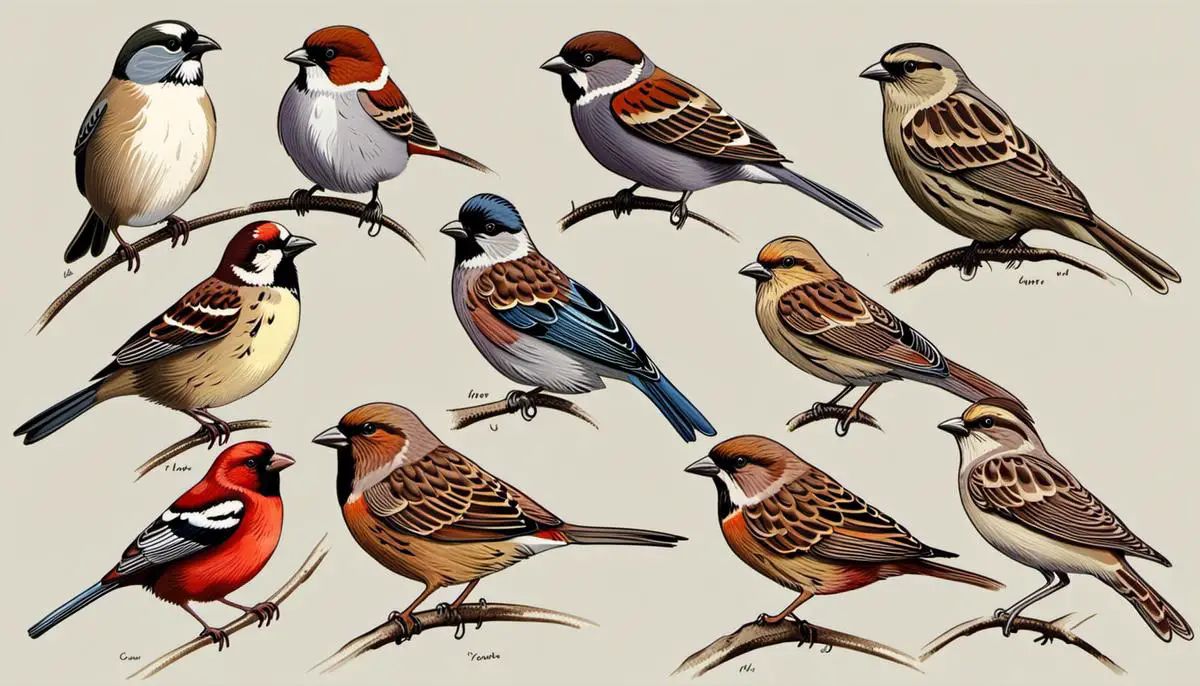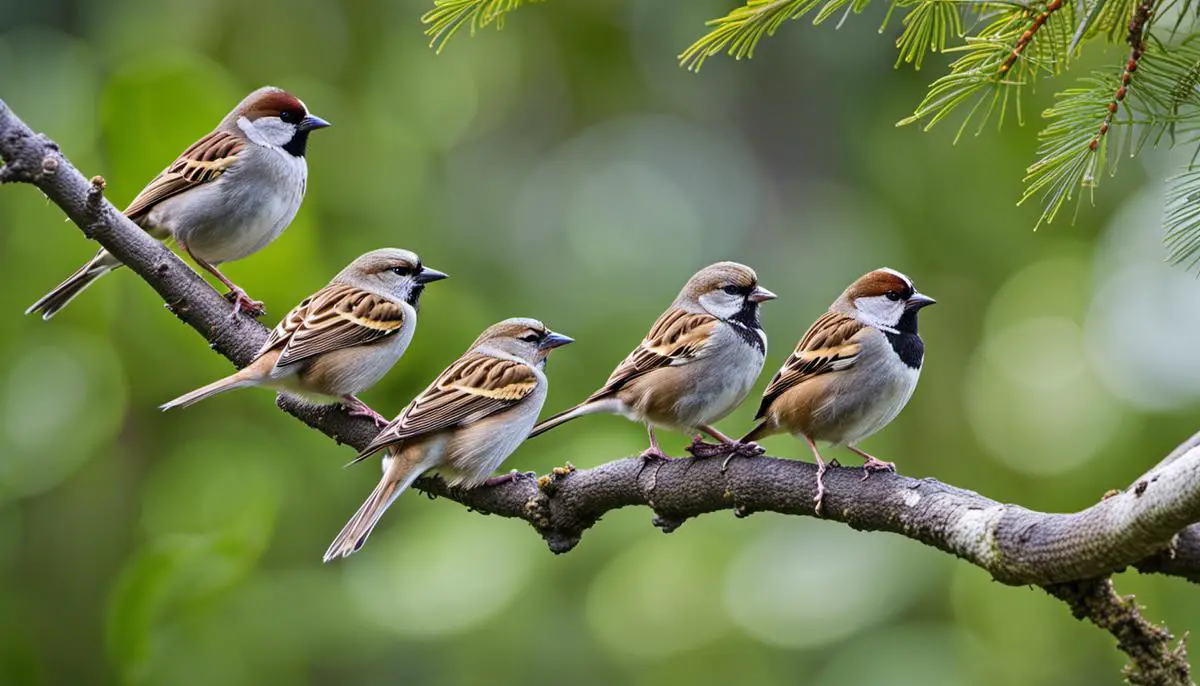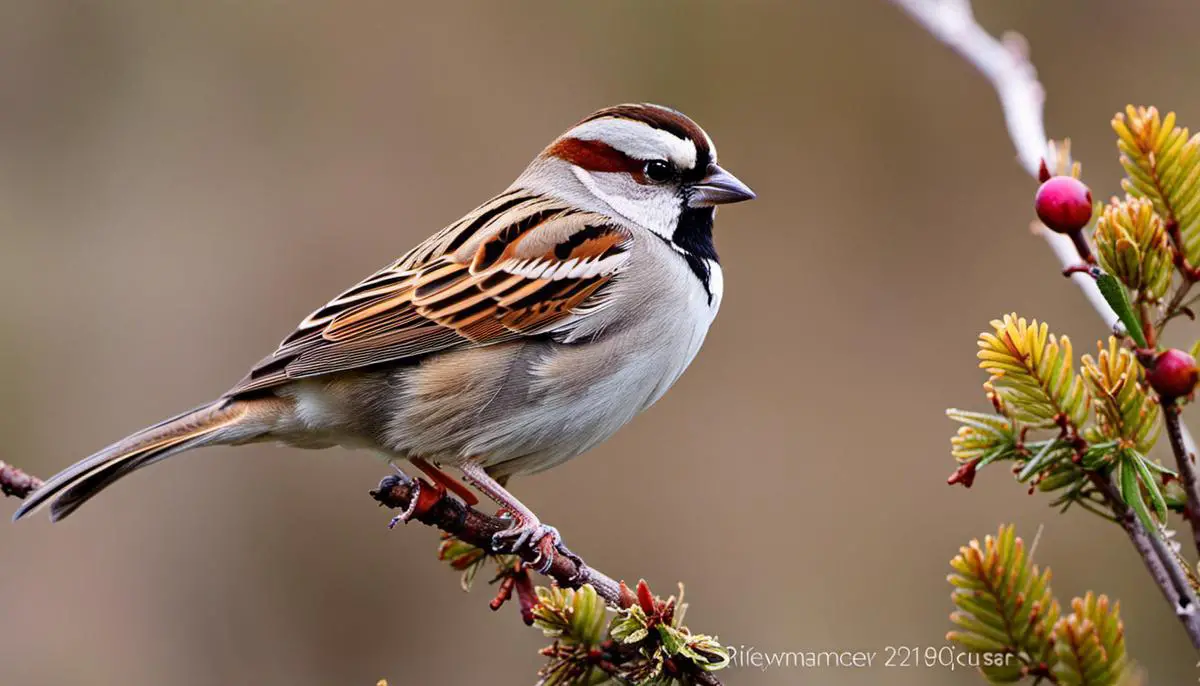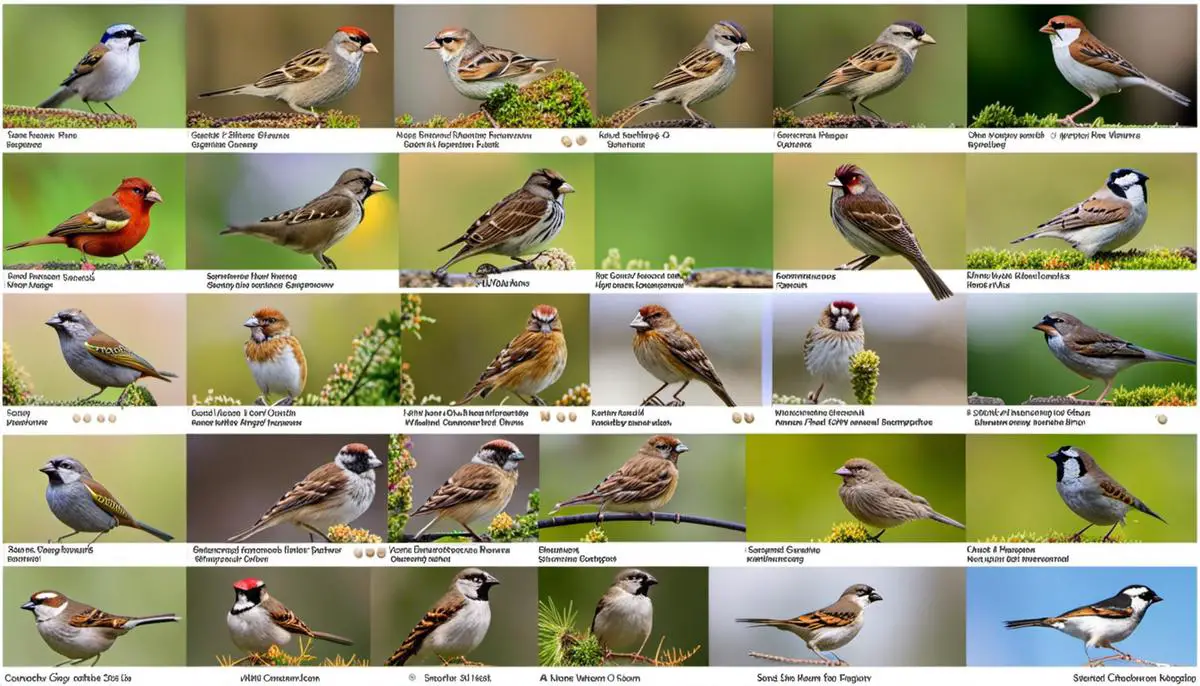How long do sparrows live? Our informative guide has the answers. Learn about the average lifespan of sparrows, as well as the oldest recorded sparrow. Discover the factors that can impact their lifespan and how to create a welcoming habitat for these birds.
The House Sparrow, a bird that is widely known yet often overlooked, offers an intriguing life story filled with survival, adaptation, and resilience. These small birds have successfully inhabited varied environments worldwide due to their remarkable adaptability and survival strategy. They serve as crucial indicators of urban biodiversity, playing a pivotal role within their ecosystems. Charming yet tenacious, sparrows exemplify the harmony of nature and its innate commitment to survival. This article aims to explore the life journey of the sparrow, delving into the diverse species, their lifespan, lifestyle behaviors, survival strategies, factors influencing their lifespan, and the impacts humans have on their existence.
Sparrow Species and Their Lifespan
House Sparrow: A Ubiquitous Bird Species
The House Sparrow is one of the most well-known and widespread species, crisscrossing a vast geographical area spanning across North America, Europe, Africa, and Asia. Though populations in some regions have witnessed a significant decline, this human-adapted bird is still thriving in many parts of the world. As for their lifespan, the typical life expectancy of a House Sparrow is estimated to be around 3 years, with the oldest recorded specimen living up to 13 years.
American Tree Sparrow: Life Amidst the Cold Tundra
Native to the northern regions of North America, the American Tree Sparrow is a hardy bird known for its incredible resilience against harsh weather conditions prevalently found in the tundra. This species exhibits relatively extended lifespans in comparison to its relatives, with an average lifespan of 10 years. However, the oldest recorded American Tree Sparrow was reported to have survived for an impressive 10.9 years.
Eurasian Tree Sparrow: A Survivor Across the Oceans
Eurasian Tree Sparrows, still comparatively less common in North America, are native to Eurasia and have found new homes in different parts of the world as introduced species. Similar to the House Sparrow, Eurasian Tree Sparrows also have an average lifespan of 3 years. With sufficient protection against predators and diseases, these birds can live beyond their average lifespan, with an advanced age record of 12 years.
Chipping Sparrow: Harmonizing Nature with Melodies
Renowned for their melodious songs, the Chipping Sparrows have the shortest average lifespan among the species mentioned thus far—just 2 years. However, exceptions to this norm certainly exist, with the longevity record for a wild Chipping Sparrow standing at 9 years and 2 months.
Fox Sparrows: Giants Among Their Kin
Fox Sparrows, one of the largest sparrows by size, are renowned not just for their large stature but also for their long lives. The majority of Fox Sparrows have been observed to live for 3 years on average, but the maximum recorded lifespan in the wild is an impressive 10 years.
The longevity of sparrows is heavily influenced by a variety of factors, such as predation, illnesses, loss of habitat, and the availability of nutrients. It’s crucial that we implement sufficient conservation strategies to sustain these remarkable creatures, ensuring their continuous existence in our world.

Factors Influencing the Lifespan of Sparrows
Understanding Factors that Affect a Sparrow’s Lifespan
Theoretically, Sparrows have the potential to live up to 13 years in their natural environment. However, their average lifespan often falls to about 4 to 5 years, mainly due to a range of variables that impact these petite birds directly.
Nutritional Intake
The typical dietary intake of a sparrow includes seeds, berries, insects, and caterpillars, particularly during the reproduction period. The availability and standard of these food sources substantially influence their lifespan. Lack of nutritional diets could leave sparrows vulnerable to health conditions, consequently shortening their lifespan.
Predation
Sparrows are often prey for larger birds and various animals, including cats and dogs. Predation is a significant factor in mortality rates among sparrows. Their small size and ground feeding habits make them easy targets. In urban environments, sparrows need to adapt to evade numerous threats, which can shorten their lifespan.
Diseases
Several diseases also pose a threat to the lifespan of sparrows. One of the most common diseases that affect these birds is avian pox, a highly contagious virus that causes growths on the skin. Other diseases include avian influenza and the West Nile Virus. The prevalence of these diseases and the sparrow’s exposure to them can significantly decrease their lifespan.
Habitat
Sparrows are highly adaptive and can live in a variety of habitats ranging from forests and grasslands to urban cityscapes. However, the habitat they reside in directly influences their lifespan. Factors such as availability of food and nesting sites, the presence of predators, human disturbance, climate, and environmental pollution can all impact their longevity. Urban environments, with their distinct challenges, often reduce the lifespan of sparrows compared to rural or natural settings.
Climate Change and Other Factors
Climate change is also affecting the lifespan of sparrows. Changes in weather patterns can affect food availability, increase the incidence of diseases, alter habitats, and contribute to more extreme weather events. All these can negatively influence the lifespan of sparrows. Additionally, other factors like road traffic, window collisions, or exposure to toxins can also shorten the life expectancy of these birds.
Brief Overview
Various factors directly influence the lifespan of sparrows. By understanding these variables, we can refine conservation efforts to increase the life expectancy of sparrows in both rural and urban environments.

Sparrow Lifestyle and Survival Strategies
Difference Between Sparrow Species and Their Lifespan
Sparrows, small and agile birds known for their harmonious songs and predominantly brown and gray colors, are broadly classified into approximately 140 species worldwide. Some of the most common species found in North America include the House Sparrows, Chipping Sparrows, and Song Sparrows. The lifespan of sparrows varies significantly according to the species. For instance, House Sparrows typically live for 1 to 3 years, although some individuals have been known to live for up to 13 years. Similarly, Song Sparrows have an average life expectancy of 10 years, with the oldest recorded individual reaching the age of 11.
Survival Strategies of Sparrows
Sparrows have various survival strategies. They are mainly granivorous, but their diet also includes insects, which allow them to meet the nutritional requirements essential for survival. Sparrows also have a robust defense mechanism. When threatened, they tend to fly in a zigzag pattern to avoid predators. Moreover, sparrows live in colonies, and larger groups mean extra eyes looking out for danger. This social behavior boosts their survival rate.
Mating Habits of Sparrows
The mating habits of sparrows also contribute to their survival. They breed once or twice a year, with each clutch having four to five eggs on average, ensuring a steady population growth. Sparrows are known for their monogamous nature, but some species partake in polygynous mating behaviors. Male sparrows woo females by singing and showing off their nests.
Sparrows’ Adaption to Human Development
Sparrows have also successfully adapted to human development, a trait that has significantly improved their chance of survival. They thrive in urban and suburban areas by scavenging for food and nesting in buildings. However, this adaptability doesn’t always work in their favor, as loss of natural habitat and pollution can decrease their lifespan.
Threats to Sparrows’ Lifespan
Despite these survival strategies, sparrows face threats that can lower their lifespan. House sparrows, for example, are experiencing declining populations in many parts of their range due to habitat loss, use of pesticides, and predation. On the other hand, initiatives like the provision of birdhouses and feeding stations can help increase their survival rate.
Generally, the lifespan of sparrows is determined by a variety of factors including the species they belong to, their diet, their natural defense abilities, mating habits, and their adaptability to human advancements. They also face numerous threats globally which affect their life expectancy. However, with certain suitable measures and interventions, we can help in the enhancement of the lifespan of these small, cheerful birds.

Human Impact on Sparrow Lifespan
The Influence of Humans on Sparrow’s Lifespan
Spanning different species, a sparrow’s life expectancy in the wild often ranges between 3 to 13 years. Their life spans are conditioned largely by factors such as the availability of food, exposure to predators, and susceptibility to disease. However, recent shifts in understanding have brought to light the immense impact that human activities bear on the lifespan of these birds.
Habitat Loss
One such human impact is habitat loss. The expansion of human settlements, industrialization, and agriculture all contribute to the loss of suitable habitats for sparrows. This habitat loss directly limits their nesting sites and sources of food. Notably, sparrows use various types of shrubbery and trees for nesting, which are often removed during the development of roads and buildings. As urbanization increases, their natural habitat is continually under threat, reducing their survival chances and consequently their lifespan.
Pollution
Pollution also plays a substantial role in the shortened lifespan of sparrows. Exposure to pollutants, especially air and water pollutants, has harmful effects on the birds’ health – it can cause respiratory issues, decrease their fertility, affect their food sources, and increase their vulnerability to diseases, reducing their lifespan considerably.
Air pollutants like aerosols, sulfur dioxide, and nitrogen oxide – produced by industries and vehicles – can cause direct lung injury to sparrows and other avian species. Furthermore, water polluted with heavy metals and pesticides can contaminate the insects and seeds sparrows feed on, leading to ingestion of these poisonous substances.
Climate Change
Lastly, the impact of climate change cannot be understated when discussing the lifespan of sparrows. Changes in temperature and precipitation patterns can disturb their breeding and migration patterns. Unpredictable changes in weather might make their survival harder, by making food resources scarce, or exposing them to severe weather events they are not adapted to withstand – these stressors ultimately reduce their longevity.
In the light of these challenges, numerous conservation efforts are being made at different levels to protect sparrows and their habitats – in recognition of the critical role they play in our ecosystems, as well as their cultural significance. This includes designated preservation areas, regulations to control pollution, and guidelines for urban planning.
Despite this, sparrows continue to face significant threats from human activities, making it increasingly important to manage and mitigate these impacts. The longevity of sparrows depends heavily on how successfully we can balance our needs with the preservation of their environments.

Across the globe, the humble sparrow thrives in an array of environments. They have evolved over generations to adapt to changing habitats and survive against the odds. Although faced with numerous challenges, sparrows utilize varied survival strategies, demonstrating the sophistication of nature’s design. An overview of their life, from distinct species variations to factors influencing lifespan, underscores their resilient spirit. Additionally, appreciating the negative impacts of human actions on sparrows emphasizes the importance of environmental protection. In understanding more about these fascinating birds, we uncover not merely scientific facts, but invaluable lessons in resilience, adaptability, and the impact of our actions on the environment.
How Long Do Sparrows Live : FAQs
Q. How long do sparrows typically live?
The lifespan of sparrows can vary depending on the species, but on average, they can live anywhere from 2-8 years in the wild.
Q. What factors can impact the lifespan of sparrows?
Several factors can impact the lifespan of sparrows, including predation, disease, habitat loss, and exposure to pesticides and other toxins.
Q. What is the oldest recorded sparrow?
The oldest recorded sparrow was a House Sparrow that lived to be 15 years and 9 months old.
Q. Do sparrows have a shorter lifespan in urban areas?
Sparrows in urban areas may have a shorter lifespan due to factors such as increased predation, exposure to pollutants, and a lack of suitable nesting and foraging habitat.
Q. How can I help increase the lifespan of sparrows?
To help increase the lifespan of sparrows, you can provide suitable nesting and foraging habitat, avoid the use of pesticides and other toxins, and support conservation efforts to protect their natural habitats.
Q. Do sparrows have a shorter lifespan in captivity?
Sparrows in captivity can have longer lifespans than those in the wild, with some individuals living up to 20 years or more. However, it’s important to note that caring for captive birds requires specialized knowledge and resources, and keeping wild birds as pets is generally not recommended.













